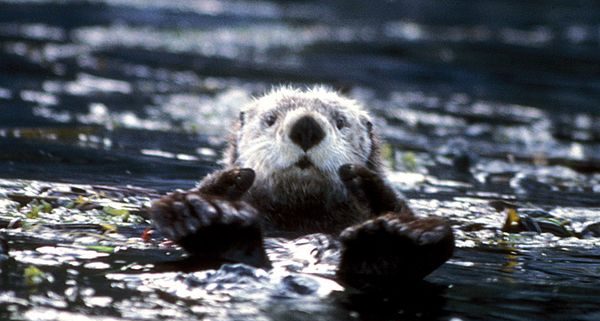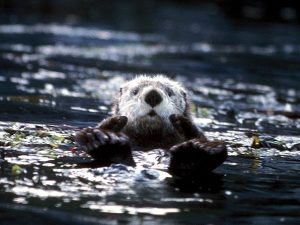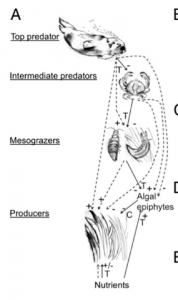Sea Otters: Their Role in Controlling the Abundance of Other Organisms
by Jessica Wingar, RJD Intern
Sea otters, Enhydra lutris, are very playful and charismatic marine organisms. They can often be seen swimming on their backs, just floating in the ocean. In addition to the fact that they are extremely charming creature, they have very many distinct qualities that not many other marine animals possess. Sea otters can often be seen using tools. By this, it is meant that they use rocks and whatever other objects that they can find in the ocean. They use these tools to crack open the shells of crustaceans, which happen to be one of their main sources of food (“Sea Otter”). Not only are sea otters important because of their unique tool use, but they also play a critical role in the food chain of the ecosystem that they live in.
Every ecosystem on the entire planet, has a system of what organism eats what and how these organisms affect each other. This cascade of organisms is often referred to as a trophic pyramid. In this pyramid there are different levels. Starting at the bottom, the levels go from the primary producers to the primary consumers to as many consumers as the system has, and then finally to the top consumers, which are the predators (Garrison, 2010). There are many ways in which these systems are controlled. Tropic cascades that are controlled top down are systems in which the consumers control the abundance or the lower levels, and systems that are controlled bottom up are systems in which the amount of consumers is limited by the availability of resources that are at the lower levels (Richardson, 2013). With increasing anthropogenic affects on ecosystems, what controls top up and bottom down is rapidly changing.
Sea otters and their interaction with other organisms in their environment, are often used as a classical example of a trophic cascade. As mentioned previously, sea otters like to feed on crabs. These crabs like to feed on seagrass in their marine community. Thus, sea otters control the abundance of crabs and crabs control the abundance of seagrass in their oceanic ecosystem. However, human affects have altered some top down and bottom up controls on this community. Some of the top down anthropogenic affects include hunting of the top predators. An example of this would be killing sea otters for their fur. Some bottom up controls include increasing the amount of nutrients in the water. The increase of nutrients comes from run off from the land. The question is, does the increase in sea otters, still cause the crab community to decrease and the seagrass community to increase?
It is critical to know what is happening with the seagrass community because of the number of sea otters in the ecosystem because seagrass has a very important ecological role. Seagrass serves as food for crabs, it controls secondary production, and it can also serve as a nursery habitat for many organisms. Since, sea otter decline has been happening for many years, when a sea otter community began to increase in numbers and nutrient run off increased in this area, it provided scientists with a perfect opportunity to study this trophic cascade.
There was a study conducted in Elkhorn Slough in California. One of the most staggering facts from this survey was that when sea otters recolonized the area in 1984, the eelgrass population increased by 600%, which definitely displays that sea otters have something to do with the population of seagrass. According to the trophic cascade, an increase in sea otters would lead to a decrease in the crab population. It was discovered that the crab population did decrease. It was concluded that sea otters were one of the main causes of this decrease because during this time, other predators in the ocean, such as sharks, were in decline due to overfishing. In addition, during this time crab harvesting had gradually decreased in this area because it became a Marine Protected Area in 2007. In addition to studying history and the current populations of sea otters, crabs, and eelgrass, these researchers did a computer model of the area, and they found the same results. Sea otters are controlling the amount of crabs and seagrass present in their communities, and are crucial to the well running of their habitats (Hughes et al, 2013).
REFERENCES
Garrison, T. (2009). Oceanography:an invitation to marine science. (7th ed.).
Hughes, B.B., Eby, R, Van Dyke, E, Tinker, T, Marks, C.I., Johnson, K.S., and Kerstin Wasson. “Recovery of a top predator mediates negative eutrophic effects on seagrass.” PNAS. 110.38 (2013): 15313-15318.
Sea otters. (2013). Retrieved from http://animals.nationalgeographic.com/animals/mammals/sea-otter/
Richardson, Jill. “Feeding Ecology and Behavior.” MSC 350. University of Miami, Coral Gables. Mar. 2013. Lecture.






Leave a Reply
Want to join the discussion?Feel free to contribute!